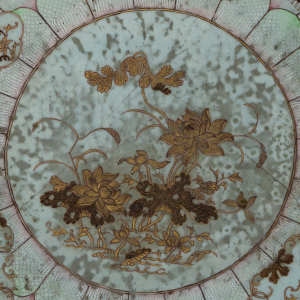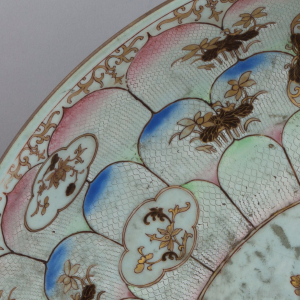Plate
Author: Unknown
Origin: China
Dating: c.1745-1765 (Qing Dynasty, Qianlong period)
Material: Porcelain
Dimensions (cm): Ø 57,5
Inv. no.: PD0089
A punch bowl plate. The punch bowl is of white porcelain with a faintly blueish tone. Its well displays a medallion with leaves and lotus flowers sprouting from water. On the exterior wall, three large portions containing floral decorations stand out, flanked by large lotus petals. The well of this plate is also decorated with a lotus corollas and petals.
The paintwork in the punch bowl and in the plate suggests they are “famille-rose” objects. In the Topkapi Saray Museum in Istanbul (Turkey), three identical punch bowls and a platter were dated from circa 1745-1765.
Punch bowls were used to serve punch, a popular beverage in the 18th century. Punch was often made with an alcoholic drink, fruit juice and a sweetener. It could be served either hot or cold.
“Flora in the Palace’s Collections”
«The lotus flower Nelumbo nucifera – also known as the sacred lotus – does not belong to the Nymphaeaceae family of Egyptian lotuses (or water lilies) which are extensively familiar in Europe. The West became familiar with the sacred lotus later, through the transmission of ornamental motifs from the Silk Road.
The importance of the lotus flower as a Buddhist symbol par excellence has made it one of the most frequently depicted flowers in Chinese art. It embodies the concepts of highest purity and perfection – as it blooms immaculately from muddy waters – and serves as a model for Buddhists in understanding how to live with integrity and harmony in the midst of the iniquities of the world they inhabit. The depiction of the flower with eight stylized petals identifies the Noble Eightfold Path of Buddhist teachings.
Seasonally, lotus flowers represent summer (for they bloom from early June to late August), conceptualizing maturity, especially when in presence of other summer plants. Along with other flowers such as chrysanthemums, Prunus flowers and peonies – each associated with a time of year – they allude to the annual cycle of the seasons.
[…]
[The] lotus was prominent in the blue and white decoration of porcelain, dating from the second quarter of the 18th century onwards, on shang ping vases designed for the Imperial circle, so that the emperor could instil the spirit of purity and incorruptibility in the Court officials.»
Sasha Assis Lima





